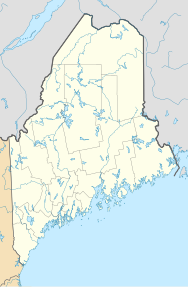Skowhegan, Maine
| Skowhegan, Maine | ||
|---|---|---|
| Town | ||

Water Street in 1906
|
||
|
||
| Motto: A Place to Watch | ||
| Location within the state of Maine | ||
| Coordinates: 44°45′53.31″N 69°43′6.20″W / 44.7648083°N 69.7183889°W | ||
| Country | United States | |
| State | Maine | |
| County | Somerset | |
| Settled | 1771 | |
| Incorporated (town) | February 5, 1823 | |
| Area | ||
| • Total | 60.47 sq mi (156.62 km2) | |
| • Land | 58.85 sq mi (152.42 km2) | |
| • Water | 1.62 sq mi (4.20 km2) | |
| Elevation | 223 ft (68 m) | |
| Population (2010) | ||
| • Total | 8,589 | |
| • Estimate (2012) | 8,552 | |
| • Density | 145.9/sq mi (56.3/km2) | |
| Time zone | Eastern (EST) (UTC-5) | |
| • Summer (DST) | EDT (UTC-4) | |
| ZIP code | 04976 | |
| Area code(s) | 207 | |
| FIPS code | 23-68910 | |
| GNIS feature ID | 0579029 | |
Skowhegan /skaʊˈhiːɡən/ is the county seat of Somerset County, Maine, United States. Skowhegan was originally inhabited by the indigenous Abenaki people who named the area Skowhegan, meaning "watching place [for fish]." The native population was massacred or driven from the area during the 4th Anglo-Abenaki War. As of the 2010 census, the town population was 8,589. Skowhegan School of Painting and Sculpture is an internationally known residency program for artists, though it is technically located in neighboring East Madison. Every August, Skowhegan hosts the annual Skowhegan State Fair, the oldest continuous state fair in the United States.
For thousands of years prior to European settlement, this region of Maine was the territory of the Kinipekw (later known as Kennebec) Norridgewock tribe of Abenaki). The Norridgewock village was located on the land now known as Madison. The Abenaki relied on agriculture (corn, beans, and squash) for a large part of their diet, supplemented by hunting, fishing, and the gathering of wild foods. The Skowhegan Falls (which have since been replaced by the Weston Dam) descended 28 feet over a half-mile on the Kennebec River. From spring until fall the tribe fished here, where abundant salmon and other species could be caught by wading. They speared salmon and other fish in the pools beneath two waterfalls there and utilized the rich land on its banks to raise corn and other crops. This place was an important stop on their annual migrations from northern hunting grounds in winter to coastal Maine in summer. They dried fish on the Island in early summer and planted crops to be harvested on their return northward in autumn. Consequently, they named the area Skowhegan, meaning "watching place [for fish]." Early variant names include Schoogun, Squahegan, Cohegan, Cohigin, Schouhegan, Scohigin, Cohiggin, Scowhegan, Scohegan, Scunkhegon, Squhegan, Sou heagan, Sou Heavyon, etc.
...
Wikipedia


